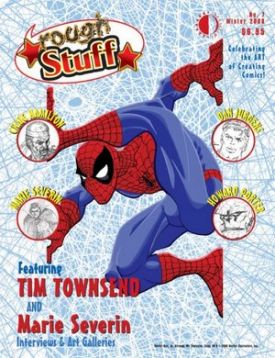- Comics
- Comics Reviews
- Manga
- Comics Reviews
- European Comics
- News
- Comics News
- Press Releases
- Columns
- Spotlight
- Digital Comics
- Webcomics
- Cult Favorite
- Back Issues
- Webcomics
- Movies
- Toys
- Store
- More
- About
By Leroy Douresseaux
April 16, 2008 - 10:06
 |
| Tim Townsend's catchy Spider-Man cover for this issue. |
ROUGH STUFF #7
Rough Stuff, TwoMorrow Publishing’s magazine that looks at the artists who draw comics and the art they create, is obviously geared towards people who collect original art, sketches, preliminary drawings, unused pencils pages, etc. Edited by respected inker and New Mutants co-creator, Bob McLeod, Rough Stuff is also a gift to comic book fans who love to get a behind the scenes look at what goes into designing, producing, and drawing the visual side of comic books.
As is usual, Rough Stuff #7 is packed with the good stuff. McLeod interviews popular inker, Tim Townsend. Probably best known for inking Chris Bachalo and Joe Madureira (who could use him on Ultimates 3), Townsend, lively and talkative, discusses his influences, technique and style, the industry, how he approaches inking each artist, and his opinion on the state of inking. McLeod encourages him, and the result is engaging and fun to read.
Rough Stuff contributor Dewey Cassell offers an excerpt of an interview he conducted with the Queen, Marie Severin. From the late 60’s to the early 70’s, Ms. Severin designed virtually every Marvel comic book cover, and this eight-page interview is packed with examples of both her cover designs and the final cover art.
The “Feature Artists” section allows comic book artists to open up their sketchbooks to show us the comic book pages that they drew in pencil before the pages were inked. The 14-page section of Dan Jurgens (Booster Gold, Superman) includes several examples of comic book art in various stages – from preliminaries and thumbnails to breakdowns and finished pencils. Sandy Plunkett shares examples of his beautiful illustrations. The final featured artist is Chris Samnee, and the 16-page article is packed with Samnee’s pencil pages, all of which reveal him to be an exceptionally talented unknown.
For all its love of the art of comic books, Rough Stuff has become, in a sense, a teaching tool for McLeod. He offers his commentary in addition to the artists’ on many of the pencil samples included in each issue, pointing to things in each drawing of which artists should take note. McLeod also uses the two-page feature, “Rough Critique” to evaluate sample pages from aspiring pencillers. It’s a way for artists, especially for pencillers with not much experience, to learn from respected veterans and from a highly-skilled inker like McLeod himself.
A
To see art that Bob couldn’t include in Rough Stuff because of space considerations go to www.bobmcleod.com/roughstuff.htm.